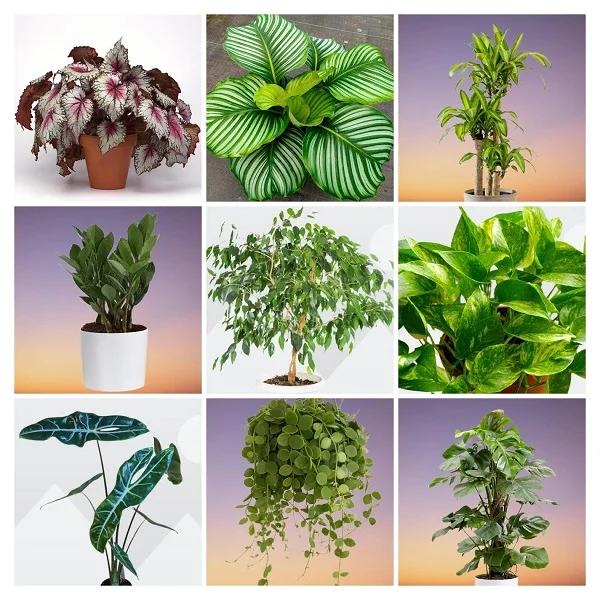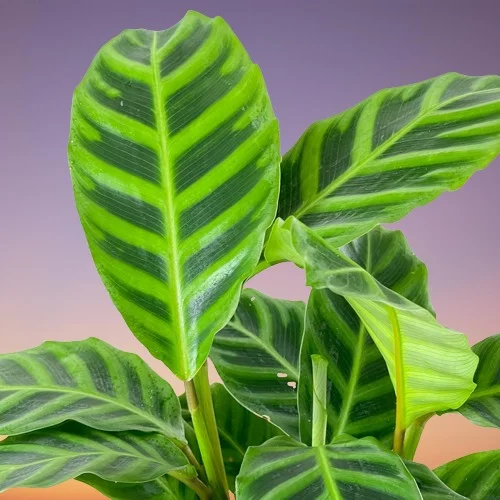Calathea picturata (Goeppertia picturata) Indoor Care: Light, Watering, Fertilizer, Pruning, Propagation
Some links in this post may be affiliate links
Calathea picturata (Goeppertia picturata) thrives in medium to bright indirect light, average warmth, humid conditions and consistently moist, rich, well-drained soil coupled with monthly feeding in the growing season.
Goeppertia picturata is among the popular Calathea varieties on account of its spectacular foliage where the intense colour in the centre of its leaves is surrounded by a band of green colouring along the edges while the undersides are a purple-burgundy color.
Goeppertia picturata comes in two variants; silver and crimson. The silver variant commonly called 'Argentea', is more common and has a silvery green center. The crimson variant is rarer and has a crimson-red center. Calathea picturata is one of the best plants for the home and will create a magnificent sight in any space.
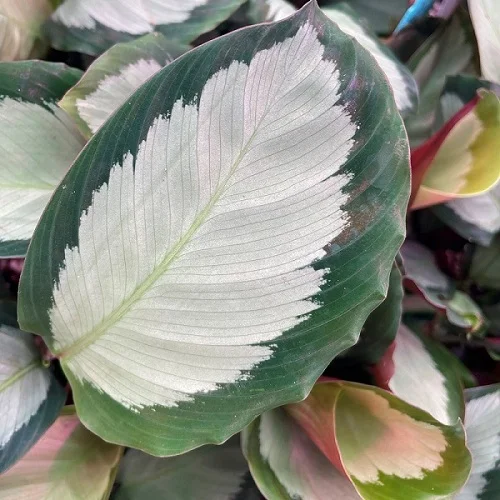
Botanical name: Calathea picturata
Synonym: Goeppertia picturata
Family: Marantaceae
Common name: Calathea picturata
Origin
Calathea picturata is native to the tropical forests in North Brazil where it grows on the forest floors and is a favorite tropical foliage plant.
Size
Goeppertia picturata grows in clumps to a height of about 1-2 feet which makes it one of the best low-light plants for the limited spaces.
Flower
Goeppertia picturata is not grown for the flower but for the spectacular foliage and is unlikely to flower under room conditions.
Is Calathea picturata toxic?
No. Calathea picturata like like other Calathea Plants is non-toxic to humans and pets as indicated by ASPCA. Calathea picturata is safe for cats, dogs and other pets.
Related Plants
Calathea picturata is related to the Marantas, Ctenanthe and Stromanthe which are collectively called Prayer Plants in reference to their curious characteristic of closing their leaves at night.
Where to buy
If you would like to add these Calathea picturata to your collection, you may acquire them online from Amazon (Link to Amazon) or from Etsy (Link to Etsy).
How to care for Calathea picturata indoors?
To care for Calathea picturata indoors, provide medium to bright indirect light, average warmth of 15-260C, humidity of 60-80% and consistently moist, fertile, well-drained soil coupled with monthly feeding during the growing season.
Goeppertia picturata care requires pruning to keep it neat and also reduce pest and disease infestations. Repotting is needed only when the plant becomes pot-bound. Keep reading for more on the best growing conditions and how to achieve them.
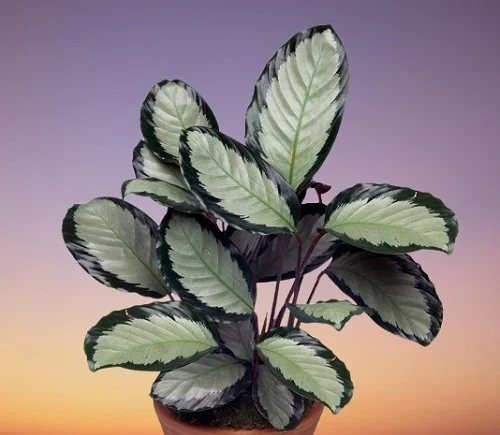
Temperature & Humidity
Calathea picturata prefers an average warmth of 15-260C. Keep it away from drafts as they cause temperature flactuations which results in stunted growth and eventual death of the plant if not corrected.
Goeppertia picturata requires a humidity of 60% to 80%. Too low humidity will result in brown leaf tips and edges. Use a hygrometer to monitor the humidity for the optimum growth of the plant. To elevate humidity, set the pot on a wet pebble tray or use a humidifier. Maintain a good air circulation to discourage fungal diseases.
You may also grow the plant in a well-lit bathroom, kitchen, laundry area and other moist areas in the home. Calathea picturata is one of the best plants for the bathroom on account of its requirement for warm, humid conditions.
The plant can also be grown in a closed terrarium where a high humidity can be easily maintained inside a terrarium and is among the best plants for a closed terrarium.
Light Requirements
Calathea picturata grows best in medium to bright indirect light. Place it near a bright window. Keep it away from direct sunlight to prevent scorching of the leaves and loss of leaf color.
Where the natural light is not adequate, the plant will grow slowly and become leggy. Therefore, instal a full spectrum grow light to supplement it.
For uniform growth to prevent lopsided growth, turn the pot regularly to ensure that the plant receives light on all sides.
Watering
Water Calathea picturata liberally in spring and summer while allowing the top 1-2 inches of soil to dry out between waterings. Keep the soil consistently moist but not soggy to prevent rotting and yellowing.
Reduce watering in fall and winter as growth is minimal at this time. Do not allow the soil to dry out completely to avoid wilting and drooping.
Use water that is at room temperature to prevent plant shock. The water should be free of chlorine and flourides as they will cause brown leaf tips and edges.
Ascertain that the pot has a drainage hole and the soil is free-draining to prevent waterlogging which can result in root-rot and loss of the plant.
To reduce fungal infestations, avoid wetting the foliage during watering; water from the bottom instead.
Fertilizer
Feed Calathea picturata with a balanced, liquid fertilizer every 4 weeks in spring and summer for a lush growth.
Do not feed in fall and winter as growth is minimal and feeding at this time can lead to fertilizer burn.
Flush out accumulated salts from the soil by running a stream of water through the soil. Allow the stream of water to run for some time and repeat the process several times.
Potting Soil
The best potting soil for Calathea picturata is rich in organic matter and free-draining to prevent waterlogging while providing the required nutrients.
Repotting
Repot Calathea picturata every 2-3 years at the beginning of the growing season (spring to early summer) or when it becomes root-bound. Take care not to injure its delicate roots.
Use a pot one size larger than the current one and ensure that the pot has a drainage hole to prevent the soil from getting soggy as it can lead to root-rot.
At least one day before repotting, water the plant thoroughly to hasten establishment. A well hydrated plant suffers less repotting shock and takes a shorter time to take root.
If the plant is large and has outgrown its current pot, divide it into several sections and use the splits to propagate new plants.
Repotting may cause the leaves to droop but the plant will eventually recover once it takes root; in about 3-4 weeks. Check out these pots with drainage holes on Amazon.
Pruning & Grooming
Pruning Calathea picturata is easy. Remove dead and yellow foliage to maintain the plant neat and discourage pests and diseases. Cut the leaves with a sharp knife or pruning scissors at the base, where the leaf meets the stalk.
Keep the leaves clean by damp-wiping with a soft cloth to get rid of dust and minimize pest and disease infestations.
Calathea picturata Propagation
Calathea picturata is best propagated by plant division at the beginning of the growing season (spring to early summer). Dividing the plant at this time hastens establishment as it is in the active growth phase.
Learn how to propagate Calathea Plants in 2 easy ways.
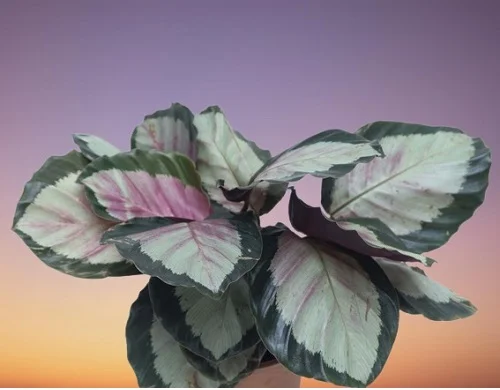
Calathea picturata Problems & Solutions
Calathea picturata (Goeppertia picturata) problems are yellow leaves, drooping leaves, plant dying, brown leaf tips, washed ot leaves, pests and diseases among others. Keep reading for more on these problems and how to solve them.
Yellow leaves
Yellow leaves on Calathea picturata is caused by incorrect watering, soggy soil or too little light.
How to fix it
Inconsistent watering: Water when the top 1-2 inches of soil dry out but never allow the soil ball to dry out completely.
Soggy soil: Use a pot with a drainage hole and well-draining soil. In addition, empty the saucer after watering.
Too little light: Place the plant where it will receive medium to bright indirect light or use a grow light if the natural lighting is too low.
Drooping leaves
The main causes of drooping leaves on Calathea picturata are dry air, inconsistent watering, soggy soil or being pot-bound.
How to fix it
Dry air: To increase humidity, set the pot on a wet pebble tray or use a humidifier.
Inconsistent watering Do not water on a schedule. Water when the top 1-2 inches of soil dry out but do not allow the soil to dry out completely.
Soggy soil: Use free-draining soil and a pot that has a drainage hole.
Being pot-bound Repot the plant into a pot one size larger than the current one or divide it into several sections to propagate new plants.
Plant dying
Some of the causes of dying in Calathea picturata are inconsistent watering, temperature stress, nutrients deficiency, low humidity, spider mites infestations and root-rot.
How to fix it
Inconsistent watering Water when the top 1-2 inches of soil dry out but do not allow the soil to dry out completely. Do not water on a schedule.
Temperature stress: Keep the plant away from drafts emanating from AC units, heat sources, windy doors, drafty windows, hot stoves among others.
Nutrients defeciency: Fertilize with a balanced, liquid fertilizer every 4 weeks in spring and summer.
Low humidity: To raise humidity, set the pot on a wet pebble tray or use a humidifier.
Spider mites infestations: Regularly check underneath the leaves for these pests and carry out timely control measures.
Root-rot: The disease is prevalent in soggy soil.
- Carefully remove the plant from its pot and inspect the roots.
- Trim the brown-black, mushy roots and treat the healthy roots with a copper-based fungicidal solution as indicated on the label.
- Disinfect the pot with the fungicidal solution or use a fresh pot to repot the plant in fresh, well-draining soil.
- Do not water the plant immediately and keep it dry for 5-7 days before you can resume watering.
- Use a pot with a drainage hole and well-draining soil to prevent the soil from getting soggy.
- Lessen watering in fall and winter as growth is slowed at this time; keep the soil slightly moist.
Brown leaf tips and edges
Brown leaf tips and edges on Calathea picturata are due to dry air, spider mites infestations, use of hard water or salts buildup.
How to fix it
Dry air: To raise humidity, set the pot on a wet pebble tray or grow the plant in a well-lit bathroom, laundry area and other moist areas in the home.
Spider mites infestation: Remove the dead growth and raise humidity for the plant to discourage the pest infestations.
Use of hard water: Water it with rain water or filtered water.
Salts buildup: Regularly, flush out accumulated salts by running a stream of water through the soil until it drains through the drainage hole.
Washed out leaves
Washed out leaves on Calathea picturata are caused by hot direct sunlight. Position the plant in a more shaded spot or instal a light curtain to filter the sunlight.
Pests
Common pests on Goeppertia picturata are aphids, mealybugs, scale insects and spidermites.
How to fix it
- Isolate the affected plant to prevent spread to the other plants.
- Treat the infested plant with neem oil or insecticidal soap as per the manufacturers instructions.
- Regularly check underneath the leaves for these pests and carry out timely control measures.
- Maintain the plant well pruned and elevate humidity to discourage pest infestation.
Diseases
Calathea picturata is prone to leaf spot disease due to the humid conditions in which it grows. The disease is indicated by brown patches surrounded by a yellow halo.
How to fix it
- Remove and burn the affected parts to reduce the risk of spread to the rest of the plants.
- Spray the affected plant with a systemic fungicide and ensure to follow the manufacturers recommendations.
- Keep the plant on the dry side and ensure good air flow.
- Use a pot with a drainage hole and well-draining soil.
You liked it? Share on social media.
Related Content
Amazon Associates Disclosure
Homeplantsguide.com is a participant in the Amazon Services LLC Associates Program, an affiliate advertising program designed to provide a means for sites to earn advertising fees by advertising and linking to amazon.com.



